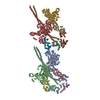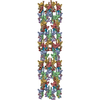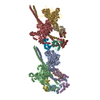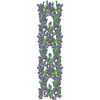[English] 日本語
 Yorodumi
Yorodumi- PDB-3jbh: TWO HEAVY MEROMYOSIN INTERACTING-HEADS MOTIFS FLEXIBLE DOCKED INT... -
+ Open data
Open data
- Basic information
Basic information
| Entry | Database: PDB / ID: 3jbh | ||||||
|---|---|---|---|---|---|---|---|
| Title | TWO HEAVY MEROMYOSIN INTERACTING-HEADS MOTIFS FLEXIBLE DOCKED INTO TARANTULA THICK FILAMENT 3D-MAP ALLOWS IN DEPTH STUDY OF INTRA- AND INTERMOLECULAR INTERACTIONS | ||||||
 Components Components |
| ||||||
 Keywords Keywords | CONTRACTILE PROTEIN / MYOSIN INTERACTING-HEADS MOTIF / CRYO-EM / THICK FILAMENT / FLEXIBLE DOCKING / SINGLE PARTICLE RECONSTRUCTION / ITERATIVE HELICAL REAL SPACE RECONSTRUCTION (IHRSR) / INTER- AND INTRAMOLECULAR INTERACTIONS / MYOSIN REGULATION / SUPER-RELAXATION / STRIATED MUSCLE / TARANTULA | ||||||
| Function / homology |  Function and homology information Function and homology informationmyosin filament organization / system development / animal organ development / A band / muscle myosin complex / myosin filament / locomotion / myosin II complex / sarcomere organization / structural constituent of muscle ...myosin filament organization / system development / animal organ development / A band / muscle myosin complex / myosin filament / locomotion / myosin II complex / sarcomere organization / structural constituent of muscle / microfilament motor activity / muscle contraction / post-embryonic development / actin filament binding / calcium ion binding / ATP binding / identical protein binding Similarity search - Function | ||||||
| Biological species |  Aphonopelma (spider) Aphonopelma (spider) | ||||||
| Method | ELECTRON MICROSCOPY / helical reconstruction / cryo EM / Resolution: 20 Å | ||||||
 Authors Authors | Alamo, L. / Qi, D. / Wriggers, W. / Pinto, A. / Zhu, J. / Bilbao, A. / Gillilan, R.E. / Hu, S. / Padron, R. | ||||||
 Citation Citation |  Journal: J Mol Biol / Year: 2016 Journal: J Mol Biol / Year: 2016Title: Conserved Intramolecular Interactions Maintain Myosin Interacting-Heads Motifs Explaining Tarantula Muscle Super-Relaxed State Structural Basis. Authors: Lorenzo Alamo / Dan Qi / Willy Wriggers / Antonio Pinto / Jingui Zhu / Aivett Bilbao / Richard E Gillilan / Songnian Hu / Raúl Padrón /    Abstract: Tarantula striated muscle is an outstanding system for understanding the molecular organization of myosin filaments. Three-dimensional reconstruction based on cryo-electron microscopy images and ...Tarantula striated muscle is an outstanding system for understanding the molecular organization of myosin filaments. Three-dimensional reconstruction based on cryo-electron microscopy images and single-particle image processing revealed that, in a relaxed state, myosin molecules undergo intramolecular head-head interactions, explaining why head activity switches off. The filament model obtained by rigidly docking a chicken smooth muscle myosin structure to the reconstruction was improved by flexibly fitting an atomic model built by mixing structures from different species to a tilt-corrected 2-nm three-dimensional map of frozen-hydrated tarantula thick filament. We used heavy and light chain sequences from tarantula myosin to build a single-species homology model of two heavy meromyosin interacting-heads motifs (IHMs). The flexibly fitted model includes previously missing loops and shows five intramolecular and five intermolecular interactions that keep the IHM in a compact off structure, forming four helical tracks of IHMs around the backbone. The residues involved in these interactions are oppositely charged, and their sequence conservation suggests that IHM is present across animal species. The new model, PDB 3JBH, explains the structural origin of the ATP turnover rates detected in relaxed tarantula muscle by ascribing the very slow rate to docked unphosphorylated heads, the slow rate to phosphorylated docked heads, and the fast rate to phosphorylated undocked heads. The conservation of intramolecular interactions across animal species and the presence of IHM in bilaterians suggest that a super-relaxed state should be maintained, as it plays a role in saving ATP in skeletal, cardiac, and smooth muscles. #1:  Journal: J Mol Biol / Year: 2008 Journal: J Mol Biol / Year: 2008Title: Three-dimensional reconstruction of tarantula myosin filaments suggests how phosphorylation may regulate myosin activity. Authors: Lorenzo Alamo / Willy Wriggers / Antonio Pinto / Fulvia Bártoli / Leiria Salazar / Fa-Qing Zhao / Roger Craig / Raúl Padrón /  Abstract: Muscle contraction involves the interaction of the myosin heads of the thick filaments with actin subunits of the thin filaments. Relaxation occurs when this interaction is blocked by molecular ...Muscle contraction involves the interaction of the myosin heads of the thick filaments with actin subunits of the thin filaments. Relaxation occurs when this interaction is blocked by molecular switches on these filaments. In many muscles, myosin-linked regulation involves phosphorylation of the myosin regulatory light chains (RLCs). Electron microscopy of vertebrate smooth muscle myosin molecules (regulated by phosphorylation) has provided insight into the relaxed structure, revealing that myosin is switched off by intramolecular interactions between its two heads, the free head and the blocked head. Three-dimensional reconstruction of frozen-hydrated specimens revealed that this asymmetric head interaction is also present in native thick filaments of tarantula striated muscle. Our goal in this study was to elucidate the structural features of the tarantula filament involved in phosphorylation-based regulation. A new reconstruction revealed intra- and intermolecular myosin interactions in addition to those seen previously. To help interpret the interactions, we sequenced the tarantula RLC and fitted an atomic model of the myosin head that included the predicted RLC atomic structure and an S2 (subfragment 2) crystal structure to the reconstruction. The fitting suggests one intramolecular interaction, between the cardiomyopathy loop of the free head and its own S2, and two intermolecular interactions, between the cardiac loop of the free head and the essential light chain of the blocked head and between the Leu305-Gln327 interaction loop of the free head and the N-terminal fragment of the RLC of the blocked head. These interactions, added to those previously described, would help switch off the thick filament. Molecular dynamics simulations suggest how phosphorylation could increase the helical content of the RLC N-terminus, weakening these interactions, thus releasing both heads and activating the thick filament. #2: Journal: BMC Genomics / Year: 2009 Title: Analysis of tarantula skeletal muscle protein sequences and identification of transcriptional isoforms. Authors: Jingui Zhu / Yongqiao Sun / Fa-Qing Zhao / Jun Yu / Roger Craig / Songnian Hu /  Abstract: BACKGROUND: Tarantula has been used as a model system for studying skeletal muscle structure and function, yet data on the genes expressed in tarantula muscle are lacking. RESULTS: We constructed a cDNA library from Aphonopelma sp. (Tarantula) skeletal muscle and got 2507 high-quality 5'ESTs (expressed sequence tags) from randomly picked clones. EST analysis showed 305 ...RESULTS: We constructed a cDNA library from Aphonopelma sp. (Tarantula) skeletal muscle and got 2507 high-quality 5'ESTs (expressed sequence tags) from randomly picked clones. EST analysis showed 305 unigenes, among which 81 had more than 2 ESTs. Twenty abundant unigenes had matches to skeletal muscle-related genes including actin, myosin, tropomyosin, troponin-I, T and C, paramyosin, muscle LIM protein, muscle protein 20, a-actinin and tandem Ig/Fn motifs (found in giant sarcomere-related proteins). Matches to myosin light chain kinase and calponin were also identified. These results support the existence of both actin-linked and myosin-linked regulation in tarantula skeletal muscle. We have predicted full-length as well as partial cDNA sequences both experimentally and computationally for myosin heavy and light chains, actin, tropomyosin, and troponin-I, T and C, and have deduced the putative peptides. A preliminary analysis of the structural and functional properties was also carried out. Sequence similarities suggested multiple isoforms of most myofibrillar proteins, supporting the generality of multiple isoforms known from previous muscle sequence studies. This may be related to a mix of muscle fiber types. CONCLUSION: The present study serves as a basis for defining the transcriptome of tarantula skeletal muscle, for future in vitro expression of tarantula proteins, and for interpreting structural and ...CONCLUSION: The present study serves as a basis for defining the transcriptome of tarantula skeletal muscle, for future in vitro expression of tarantula proteins, and for interpreting structural and functional observations in this model species. | ||||||
| History |
|
- Structure visualization
Structure visualization
| Movie |
 Movie viewer Movie viewer |
|---|---|
| Structure viewer | Molecule:  Molmil Molmil Jmol/JSmol Jmol/JSmol |
- Downloads & links
Downloads & links
- Download
Download
| PDBx/mmCIF format |  3jbh.cif.gz 3jbh.cif.gz | 960.1 KB | Display |  PDBx/mmCIF format PDBx/mmCIF format |
|---|---|---|---|---|
| PDB format |  pdb3jbh.ent.gz pdb3jbh.ent.gz | 715.5 KB | Display |  PDB format PDB format |
| PDBx/mmJSON format |  3jbh.json.gz 3jbh.json.gz | Tree view |  PDBx/mmJSON format PDBx/mmJSON format | |
| Others |  Other downloads Other downloads |
-Validation report
| Summary document |  3jbh_validation.pdf.gz 3jbh_validation.pdf.gz | 894 KB | Display |  wwPDB validaton report wwPDB validaton report |
|---|---|---|---|---|
| Full document |  3jbh_full_validation.pdf.gz 3jbh_full_validation.pdf.gz | 1022.3 KB | Display | |
| Data in XML |  3jbh_validation.xml.gz 3jbh_validation.xml.gz | 133.8 KB | Display | |
| Data in CIF |  3jbh_validation.cif.gz 3jbh_validation.cif.gz | 205.8 KB | Display | |
| Arichive directory |  https://data.pdbj.org/pub/pdb/validation_reports/jb/3jbh https://data.pdbj.org/pub/pdb/validation_reports/jb/3jbh ftp://data.pdbj.org/pub/pdb/validation_reports/jb/3jbh ftp://data.pdbj.org/pub/pdb/validation_reports/jb/3jbh | HTTPS FTP |
-Related structure data
| Related structure data |  1950M M: map data used to model this data |
|---|---|
| Similar structure data |
- Links
Links
- Assembly
Assembly
| Deposited unit | 
|
|---|---|
| 1 | x 20
|
| 2 |
|
| 3 | 
|
| Symmetry | Helical symmetry: (Circular symmetry: 4 / Dyad axis: no / N subunits divisor: 1 / Num. of operations: 1 / Rise per n subunits: 100 Å / Rotation per n subunits: 30 °) |
- Components
Components
| #1: Protein | Mass: 224542.281 Da / Num. of mol.: 4 / Fragment: SUBFRAGMENT 1 (S1) AND SUBFRAGMENT 2 (S2) / Source method: isolated from a natural source / Source: (natural)  Aphonopelma (spider) / Tissue: LEG MUSCLE / References: UniProt: A0A140UGH3*PLUS Aphonopelma (spider) / Tissue: LEG MUSCLE / References: UniProt: A0A140UGH3*PLUS#2: Protein | Mass: 17628.104 Da / Num. of mol.: 4 / Fragment: ESSENTIAL LIGHT CHAIN (ELC) / Source method: isolated from a natural source / Source: (natural)  Aphonopelma (spider) / Tissue: LEG MUSCLE / References: UniProt: A0A140UGH4*PLUS Aphonopelma (spider) / Tissue: LEG MUSCLE / References: UniProt: A0A140UGH4*PLUS#3: Protein | Mass: 21794.281 Da / Num. of mol.: 4 / Fragment: REGULATORY LIGHT CHAIN (RLC) / Source method: isolated from a natural source / Source: (natural)  Aphonopelma (spider) / Tissue: LEG MUSCLE / References: UniProt: A0A140UGH5*PLUS Aphonopelma (spider) / Tissue: LEG MUSCLE / References: UniProt: A0A140UGH5*PLUS |
|---|
-Experimental details
-Experiment
| Experiment | Method: ELECTRON MICROSCOPY |
|---|---|
| EM experiment | Aggregation state: FILAMENT / 3D reconstruction method: helical reconstruction |
- Sample preparation
Sample preparation
| Component |
| |||||||||||||||
|---|---|---|---|---|---|---|---|---|---|---|---|---|---|---|---|---|
| Buffer solution | Name: 100mM NaCl, 3mM MgCl2, 1mM EGTA, 5mM PIPES, 5mM NaH2PO4, 1mM NaN3 pH: 7 Details: 100mM NaCl, 3mM MgCl2, 1mM EGTA, 5mM PIPES, 5mM NaH2PO4, 1mM NaN3 | |||||||||||||||
| Specimen | Embedding applied: NO / Shadowing applied: NO / Staining applied: NO / Vitrification applied: YES | |||||||||||||||
| Specimen support | Details: HOLEY CARBON GRIDS. | |||||||||||||||
| Vitrification | Instrument: HOMEMADE PLUNGER / Cryogen name: ETHANE / Temp: 93 K / Humidity: 80 % Details: Blotting was performed from one side of the grid till a thin sample film on it using Whatman No 42 filter paper, then the grid was immediately plunged under gravity into liquid ethane cooled ...Details: Blotting was performed from one side of the grid till a thin sample film on it using Whatman No 42 filter paper, then the grid was immediately plunged under gravity into liquid ethane cooled by liquid nitrogen. Grids were stored under liquid nitrogen. Method: Blotting was performed from one side of the grid till a thin sample film on it using Whatman No 42 filter paper, then the grid was immediately plunged under gravity into liquid ethane cooled ...Method: Blotting was performed from one side of the grid till a thin sample film on it using Whatman No 42 filter paper, then the grid was immediately plunged under gravity into liquid ethane cooled by liquid nitrogen. Grids were stored under liquid nitrogen. |
- Electron microscopy imaging
Electron microscopy imaging
| Microscopy | Model: FEI/PHILIPS CM120T / Date: Oct 23, 2002 / Details: low dose |
|---|---|
| Electron gun | Electron source: LAB6 / Accelerating voltage: 120 kV / Illumination mode: FLOOD BEAM |
| Electron lens | Mode: BRIGHT FIELD / Nominal magnification: 35000 X / Calibrated magnification: 35000 X / Nominal defocus max: 1950 nm / Nominal defocus min: 1950 nm / Cs: 2 mm |
| Specimen holder | Temperature: 88 K / Temperature (max): 90 K / Temperature (min): 88 K |
| Image recording | Film or detector model: KODAK SO-163 FILM |
| Image scans | Num. digital images: 1008 |
| Radiation | Protocol: SINGLE WAVELENGTH / Monochromatic (M) / Laue (L): M / Scattering type: x-ray |
| Radiation wavelength | Relative weight: 1 |
- Processing
Processing
| EM software |
| ||||||||||||
|---|---|---|---|---|---|---|---|---|---|---|---|---|---|
| Helical symmerty | Angular rotation/subunit: 30 ° / Axial rise/subunit: 100 Å / Axial symmetry: C4 | ||||||||||||
| 3D reconstruction | Method: Single particle reconstruction with a modification of the IHRSR method Resolution: 20 Å / Resolution method: FSC 0.5 CUT-OFF / Nominal pixel size: 2.48 Å / Actual pixel size: 2.48 Å Details: Three-dimensional single particle reconstruction was carried out by a modification of the IHRSR method, using SPIDER. Low-dose electron micrographs of 1008 frozen-hydrated thick filaments ...Details: Three-dimensional single particle reconstruction was carried out by a modification of the IHRSR method, using SPIDER. Low-dose electron micrographs of 1008 frozen-hydrated thick filaments halves ere digitized at 0.248 nm per pixel using a Nikon Super Coolscan 8000 ED scanner. Filaments were aligned with the bare zone at the top, to ensure correct polarity in subsequent steps. A total of 15,504 segments, each 62 nm long, with an overlap of 55.8 nm, and containing aprox. 40,000 unique pairs of interacting myosin heads went into the reconstruction. As an initial reference model we used the tarantula negatively stained 3D-map, which was axially rotated, axially shifted and also out of plane tilted up to plus-minus12deg. for projection matching, giving a total of 4,095 projections (13 tilted projections plus-minus12deg. every 2deg., 45 reference rotated projections (0-90 degrees, 2deg. rotation angle), and 7 image axial shifts of 2.2 nm. The resulting 3D-map combines about 10,700 out of 15,504 filament segments, a yield of 69 percent of included segments. There are 4 helices of myosin heads, rotated 30 degrees, every 145 Angstroms. The filament segments were selected based on visual judgement of good helical order. Symmetry type: HELICAL | ||||||||||||
| Atomic model building | Protocol: FLEXIBLE FIT / Space: REAL / Target criteria: Correlation Details: METHOD--FLEXIBLE FITTING DETAILS--Protocol- Flexible Fitting. The flexible docking procedure is based on a connected (motion capture) network of identified features within the atomic model. ...Details: METHOD--FLEXIBLE FITTING DETAILS--Protocol- Flexible Fitting. The flexible docking procedure is based on a connected (motion capture) network of identified features within the atomic model. The atomic model is allowed to move according to displacements tracked by 31 control points defined by the network, in order to find the best match to the cryo-EM map | ||||||||||||
| Atomic model building | PDB-ID: 3DTP Accession code: 3DTP / Source name: PDB / Type: experimental model | ||||||||||||
| Refinement step | Cycle: LAST
|
 Movie
Movie Controller
Controller


 UCSF Chimera
UCSF Chimera


 PDBj
PDBj






